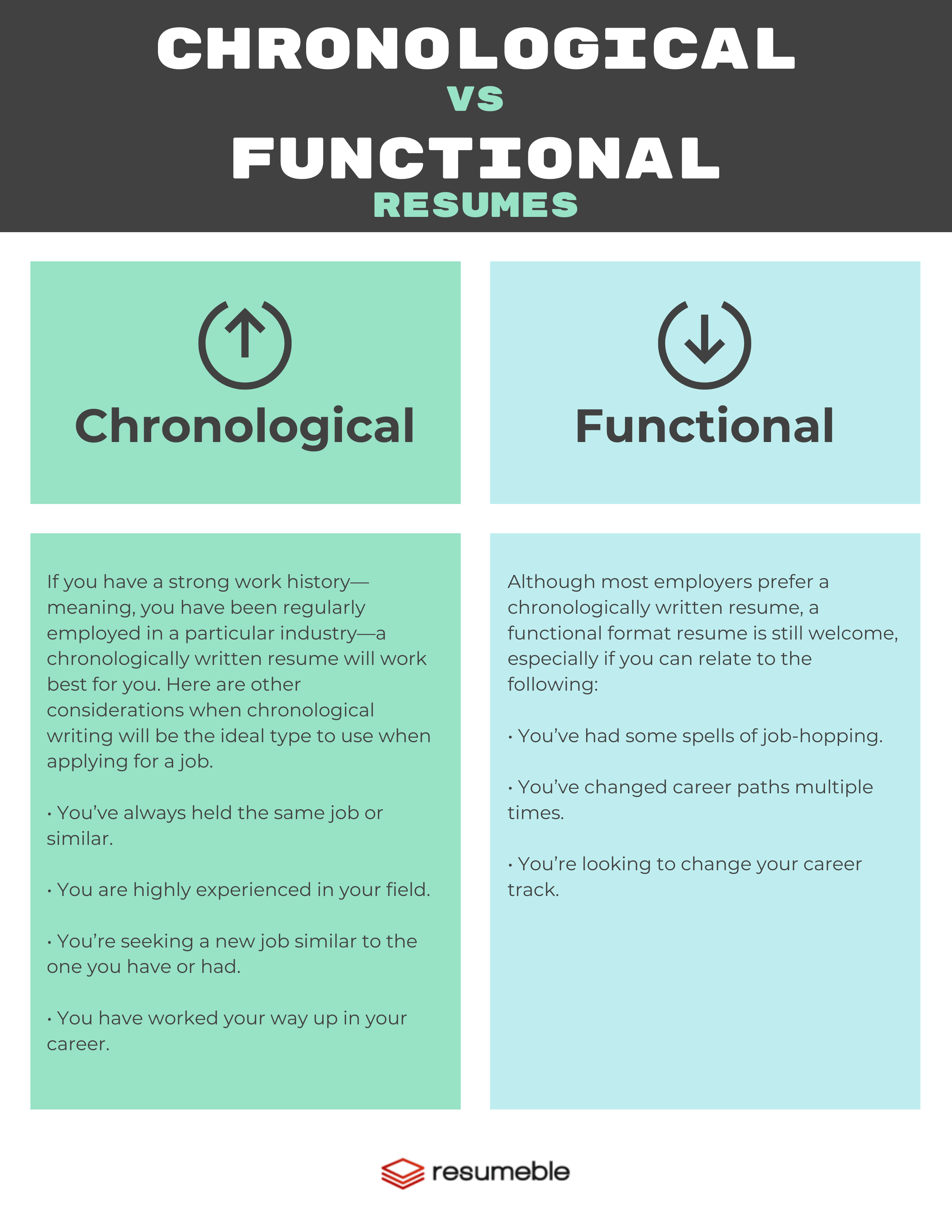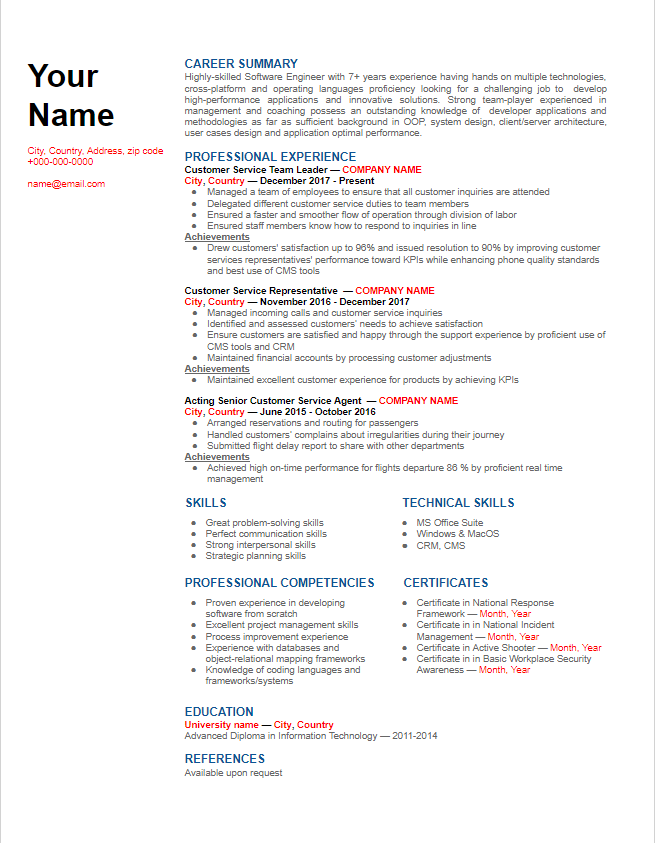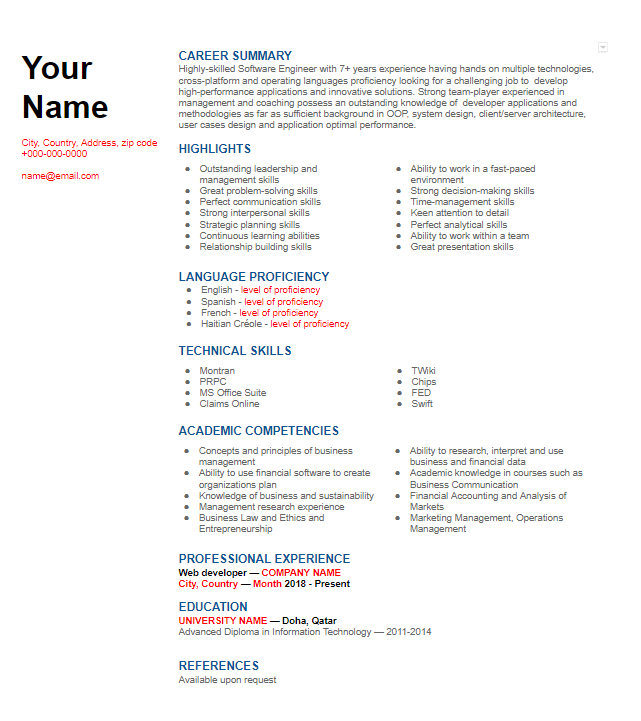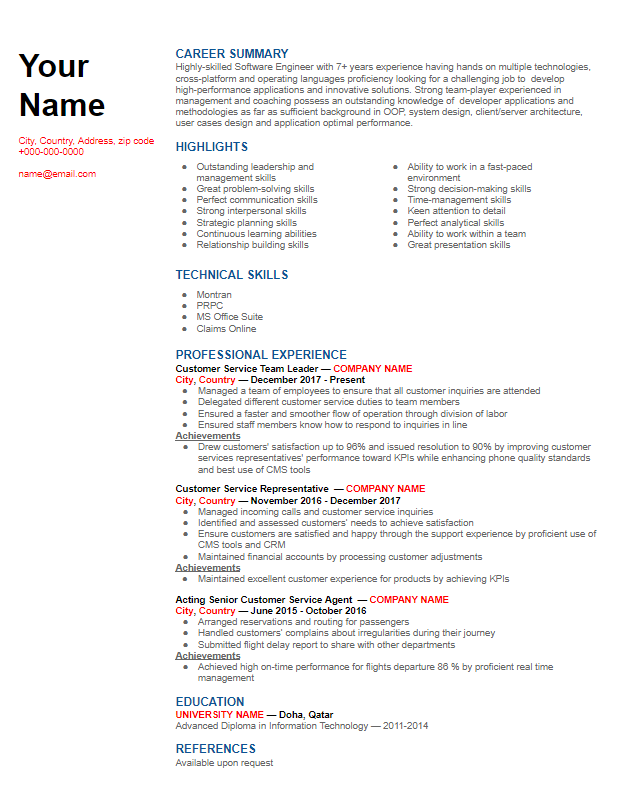Functional vs Chronological Resume with Examples
Quick Navigation:

What are functional and chronological resumes?
How to write a functional resume, how to write a chronological resume, example of a functional resume, example of a chronological resume.
Creating the perfect resume is the most important tool in your search for a new job. As you progress in your career, the resume format you choose should match where you are in your life in the manner which best suits your individual experience and capabilities. This article explains the difference between a chronological and a functional resume to help you write a winning resume that showcases your current talents and abilities.
Here are two common types of resumes:
Functional resume
The functional resume format makes your accomplishments and skills the focus as the first section listed after your name and contact information. This format is most attractive to those who are switching industries or trying to move their career in a new direction.
Chronological resume
A chronological resume (or ‘reverse-chronological’ resume) is the format most commonly used to show advancement over time and highlight achievements in past positions. It will show recruiters or employers what a perfect fit you are for the job you are applying for, based on the skill set developed throughout your career thus far.
Follow these steps to write a functional resume:
1. First, write a resume summary
Write a resume summary at the beginning of your resume that focuses on the skills you have that are relevant to the job. This is a great way to present yourself and all of your skills to the employer at first glance.
2. Second, write a ‘Skills’ section
Focus on your skills section, which is listed first on this resume, and make sure they are relevant to the job you’re applying for. Consider your unique abilities gained from special projects that might demonstrate some valuable skills you have developed and the success you have achieved.
3. Third, include your work history
While it’s not necessary to outline the exact dates of employment in your work experience, you should still include the basic employment details for each job you are listing.
4. Fourth, organize your resume
Organize your resume by category or theme. For example, if you have experience in marketing and public relations, group those skills and experiences together to promote your abilities in that area.
5. Finally, use keywords
Using specific keywords is very helpful, as they let the employer know that your skills match up with the requirements of the job.
Follow these steps to write a chronological resume:
1. First, include a summary
Begin your resume with a short summary of your skills, experience or coursework relevant to the job you are applying for.
2. Second, include your experience
Your professional experience section comes next and it should take up the most space on your resume. Highlight, in a bullet-pointed list, all of your relevant work experience, duties and responsibilities in each position as well as your major achievements.
3. Third, list your relevant skills
Include skills relevant to the job as well as your soft skills, such as leadership, organization or team player. The idea is to add some qualities that you have which make you stand out from other candidates.
4. Fourth, include your education
Your education includes any certifications you have earned, as well as your college degrees along with your major and minor, if applicable.
5. Finally, include a miscellaneous section such as ‘Hobbies and Interests’ or ‘Languages’
Any activities such as college-level sports, foreign language skills, significant volunteer work, internships or published works can go in this section.
Here is an example of a functional resume to help you create your own:
Eric Cassidy 231 River Road Austin, TX 23125 555-555-5555 [email protected]
Experienced web designer with strong graphic design skills and UX experience seeks a position in web design with a major ad agency.
Core Qualifications
- Background designing entire websites and taking them from conception to launch
- Excel at building designs with a focus on user experience
- Adept at building sites that are optimized for SEO
- Proficient at managing a team of junior web developers
Areas of Expertise
Photoshop, UX design, HTML, CSS, Dreamweaver, responsive design, media query, Microsoft Office, fluency in Spanish
- Web design: Lead web designer at an agency that designs an average of five new sites per week, meeting strict deadlines and exceeding customer expectations
- Graphic design: Lead in the design, development and implementation of graphics, layout and production of marketing materials
- Problem-solving: Designed a systematic process for testing bugs to ensure the end product delivered to the client was error-free
- Management: Oversaw a team of 10 developers, both in-office and overseas
Employment History
Senior Web Designer: September 2018-Present, Easy Street Agency, Austin, TX
Web Designer: August 2016-August 2018, Easy Street Agency, Austin, TX
Junior Web Designer: May 2014-July 2017, Magnolia Agency, Austin, TX
Austin University, 2010-2014 Bachelor of Science in Web Design
Here is an example of a chronological resume to guide you as you craft your own:
Adam Black 123 Main Street Safety Harbor, FL 33333 [email protected]
I am a passionate marketing manager looking for a position in a creative, technology-driven organization where I can utilize my superior marketing abilities to increase online traffic and sales.
Marketing Manager Gulf Coast Advertising May 2018 – Present
- Developed a new promotional campaign by bundling products together, increasing revenue by 11%
- Develop, monitor and evaluate the marketing and advertising strategy for each individual client
- Manage and implement client promotions to drive revenue
Digital Marketer Gulf Coast Advertising January 2016 – April 2018
- Developed unique content for a variety of clients to improve performance and brand awareness
- Performed keyword research to improve client ranking in the search engines
- Organized and analyzed data and marketing results and made recommendations for new directions for campaigns
Social Media Strategist BlueGreen Advertising October 2014 – December 2015
- Used social media to enhance the company brand and reach more potential customers
- Provided campaign performance reporting and analysis to senior managers and clients
- Planned and implemented complex digital marketing campaigns through a range of online channels
Professional Skills
- Google AdWords
- Facebook advertising
- Search engine optimization
- Process streamlining
- Team leadership
University of Tampa, 2010 – 2014Bachelor of Arts in Marketing
Volunteer Work
- American Cancer Society – Media team for promoting the annual gala, 2015 – Present
- Search Search Please fill out this field.
- Career Planning
- Finding a Job
Different Types of Resumes (With Examples)
:max_bytes(150000):strip_icc():format(webp)/ADHeadshot-Cropped-b80e40469d5b4852a68f94ad69d6e8bd.jpg)
Chronological Resume
Functional resume, combination resume, infographic resume, resume with profile or summary, targeted resume, nontraditional resume, mini-resume, choosing the right type of resume.
Adrian Mangel / The Balance
There are several basic types of resumes you can use to apply for job openings. You can choose to write a chronological, functional, combination, or targeted resume. Each resume type is used for different purposes. Therefore, when deciding which type of resume to use, you have to think about your current employment circumstances.
For example, a functional resume is particularly useful for individuals changing careers or those with gaps in their employment history because it emphasizes skills and experience over chronological work history. Additionally, a combination resume is ideal for candidates aiming to showcase both their relevant skills and their chronological work history.
Here's an overview of each type of resume, advice on when to use which one, and examples.
A chronological resume starts by listing your work history , with the most recent position listed first. Below your most recent job, you list your other jobs in reverse chronological order.
Employers typically prefer this type of resume because it's easy to see what jobs you have held and when you have worked at them. This is the most common resume type.
This type of resume works well for job seekers with a strong, solid work history. If you are starting your career, or if you are changing career fields, you might consider a different resume type.
Example: Chronological Resume
A functional resume focuses on your skills and experience, rather than on your chronological work history . Instead of having a “work history” section at the top of your resume, you might have a “professional experience” or “accomplishments” section that lists various skills you have developed over the years.
A functional resume also sometimes includes a resume summary or headline at the top, which details a person’s skills and achievements. A functional resume might not include one’s employment history at all or might have a concise list of work history at the bottom of the resume.
Functional resumes are used most often by people who are changing careers or who have gaps in their employment history. It is also useful for people who are new to the workforce, have limited work experience, or have a gap in their employment .
By highlighting skills rather than work history, you can emphasize how you are qualified for the job.
Example: Functional Resume
A combination, or hybrid, resume is a mix between a chronological resume and a functional resume. At the top of the resume is a list of one’s skills and qualifications. Below this is one’s chronological work history. However, the work history is not the focus of the resume and typically does not take up much space on the resume.
With this type of resume, you can highlight the skills you have that are relevant to the job you are applying for, as well as provide your chronological work history. After all, most employers still want to see your chronological work history—even if that history is not very extensive.
This kind of resume helps you highlight what makes you the best fit for the job, while still giving the employer all the information he or she wants.
Example: Combination Resume
Infographic resumes include graphic design elements in addition to or instead of text. A traditional resume uses text to list a candidate's work experience, education, and skills, while an infographic resume uses layout, color, design, formatting, icons, and font styling to organize content.
Example: Infographic Resume
A resume with a profile section includes a concise summary of an applicant’s skills, experiences, and goals as they relate to a specific job . This summary (typically no more than a couple of sentences long) helps candidates “sell” themselves to the company to which they are applying.
Adding a profile is helpful for almost any applicant. If you have extensive experience, a profile can concisely explain that experience to the hiring manager right away. If you have limited work experience, a profile can help you highlight the skills that you do have.
Example: Resume With a Profile
You can also add a headline, which is a brief phrase that summarizes why you are an ideal candidate for the job, to your resume.
A targeted resume is a resume that is customized to specifically highlight the experience and skills you have that are relevant to the job you are applying for. It takes more work to write a targeted resume than to apply with your existing resume. However, it's well worth the effort, especially when applying for jobs that are a perfect match for your qualifications and experience.
Example: Targeted Resume
Try to write a targeted resume for every job. Employers can easily see when you submit a generic resume, rather than thinking about why you are qualified for that specific job.
A nontraditional resume is a unique version of your resume that may include photos, graphics, images, graphs, and other visuals. It might be an online resume or a physical resume with infographics, as mentioned above. It could also be a video or resume on a social networking website.
Nontraditional resumes are ideal for people in creative fields who want to demonstrate their ability to create visually engaging designs or web pages. It can be a good way for a job candidate to stand out from the crowd in professions like design, web design, journalism, and more.
A mini-resume contains a brief summary of your career highlights and qualifications. It only contains the information that relates to the position you are applying for or the industry you would like to work in.
In most cases, your traditional resume will be appropriate. A mini-resume, however, can be useful at job fairs or career networking events when you're meeting with many people and want to leave them with something more than just a business card. You can also use a mini-resume when you're networking and would like your contact to pass on your information to a hiring manager or recruiter.
Example: Mini-Resume
Understanding the different types of resumes is crucial because it allows you to tailor your application to suit your unique circumstances and the type of job you're applying for. If you're in a creative field, consider a nontraditional or infographic resume. However, if you're in a more traditional field, like finance, you'll probably want to stick with a chronological resume. Additionally, using a targeted resume is always a smart choice, particularly when you're applying for a job that you're well-qualified for.
Key Takeaways
- Choose the type of resume that's the best fit for your skills and the job you are applying for.
- Chronological resumes are the most common; they list work history in reverse chronological order, with the most recent job listed first.
- Functional resumes focus on skills and experience rather than on employment history.
- Combination resumes list skills and qualifications first, followed by work history.
CareerOneStop. " Select the Best Format ."
CareerOneStop. " Headline and Summary Sample ."
- Resume Services
- How It Works
- Testimonials
- +1-866-231-9823
- Get your resume now
Chronological vs Functional Resumes
- Career Advice
- Industry Insights
Posted On 29 Jun 2021
There’s more than one way to write a resume. While you may be used to writing your resume chronologically (aka the reverse chronological resume), it may surprise you to know that there’s a different resume type, called the functional resume. Each type serves a different purpose, and one works better than the other depending on the applicant’s life circumstances. Let’s take a look at the difference between a chronologically and functionally written resume, and when it’s best to use one over the other.
Get to know the difference: chronological vs functional resume
As the name suggests, chronological or reverse chronology resumes follow a timeline. This type of resume prioritizes the applicant’s work experiences and arranges these from the latest to the earliest. It’s the most common type of resume, not to mention it’s also fairly easy to write, as long as you’ve kept track of your work history.
A functional resume on the other hand, highlights the applicant’s skills and achievements, taking the attention away from other elements that may reduce an applicant’s chances of getting hired, such as limited work experience, lengthy unemployment or inconsistent work history.
Ultimately, the difference between a chronological and functional resume all boils down to format. The sections of a chronologically formatted resume generally follows this sequence:
• Heading and personal info
• Summary statement
• Work experience
• Skills and training
• Education
• Awards, citations and certifications
As you can imagine, a functionally written resume is organized differently, with the Skills section preceding Work Experience, which is intentionally kept very brief. Often, the functional format resume only includes the last job held. Aside from this major change, the rest of the sections remain largely identical.

When to use a chronological resume
If you have a strong work history—meaning, you have been regularly employed in a particular industry—a chronologically written resume will work best for you. Here are other considerations when chronological writing will be the ideal type to use when applying for a job.
• You’ve always held the same job or similar.
• You are highly experienced in your field.
• You’re seeking a new job similar to the one you have or had.
• You have worked your way up in your career.
A chronological vs functional resume allows recruiters to track your career easier, so if your work history ticks these boxes, that’s a good indication that a chronological resume format is the one you should use.
Pros and cons of chronological resume
As with any type of resume, even the popular chronological resume has its advantages and disadvantages. Let’s enumerate the chronological resume’s pros and cons.
• Simple and straightforward format
• Easy-to-read layout
• May not be ideal for your career situation
• Can highlight negative career choices such as job hopping and/or lengthy unemployment
When to use a functional resume
Although most employers prefer a chronologically written resume, a functional format resume is still welcome, especially if you can relate to the following:
• You’ve had some spells of job-hopping.
• You’ve changed career paths multiple times.
• You’re looking to change your career track.
Frequently switching from one job to another can be glaringly obvious in a chronological resume, and it gives the impression of a lack of commitment, leaving a negative impression on hiring managers. On the other hand, if you plan on forging a new career track and leave your old one, a functionally written resume will be better for you as well.
Pros and cons of functional resume
The functionally formatted resume is especially helpful in hiding poor career choices, while ensuring that you appear as a highly qualified applicant based on your skills and expertise. That said, it also has its share of pros and cons, as you can see below.
• Allows for better matching of skills to match the job criteria
• De-emphasizes a spotty work history
• Can be difficult to follow
• Provides an incomplete picture of your employment
To ensure that your functionally written resume is as easy to read as a chronological one, you can have a trusted resume writing service like Resumeble write your resume for you. Not only that, a professionally written functional resume will attract the right attention and land you that elusive job interview, as services like Resumeble come with an interview guarantee.
Are there other resume formats I should know about?
A functional format resume is not the only alternative to a chronologically formatted resume. Other resume formats include a CV format and combination resume. Below are their definitions.
CV – short for curriculum vitae, is the application document submitted for jobs in academia, medicine, and scientific laboratories. Unlike traditional resumes that focus on experience and skills, CVs focus on credentials, providing potential employers with a comprehensive list of the applicant’s education, certification, academic experience, and affiliations.
Combination resume – combines a chronologically and functionally written resume, with the skills and qualifications listed first, followed by employment history. This format works best for job seekers who want to emphasize their skills, but have been required to include their work history in their resume by a potential employer. Likewise, this type of resume is also recommended for those who have employment gaps or worked unrelated jobs in the past. A combination resume is also known as a chrono-functional resume.
Choosing the right resume format
Choosing the perfect resume format for your application requires some serious evaluation and preparation on your part. And it all begins with identifying your application goals before you begin the resume writing process. With your goals in mind, use the tips and suggestions in this article to help you decide on the right resume format to use. Check out Resumeble’s sample resumes for ideas and inspiration.
Having trouble choosing the right resume format?
Should you write a chronological vs functional resume? It certainly helps to have a bona fide expert guiding you through the resume writing process. By choosing Resumeble , you will have a professional resume writer working with you one-on-one to build your resume and develop it into an application that showcases your qualifications in the best way possible. Get in touch with us today or send in your resume for a free, no-obligation evaluation.
- 7 seconds: this is how long your resume has either to impress or be ignored by the recruiter
- 300+: average number of applications one corporate job opening posted online receives
- 3%: number of sent resumes that result in interviews
Transform your career and beat the odds!
Similar Articles
Posted on : 10 May 2024
Posted on : 06 May 2024
Posted on : 19 Dec 2023
Posted on : 04 Dec 2023
Get a winning resume in 4 days and quickly land the career you deserve
Get a free 48-hour resume review.
get started & land your dream job
Functional VS. Chronological Resume

Resumes come in various formats, and the job you're applying for will dictate which resume format you use. In fact, the wrong format could mean an instant ‘pass’ from a hiring manager because it doesn’t communicate your experience in a way that’s right for the job posting.
As you grow your career and accumulate experience and skills, your resume will become more advanced. With more experience to sift through, veteran job seekers need to be intentional with how they present their resume.
When drafting your resume, there are a few formats to consider: a functional resume, chronological resume and combination resume. In this article, we will primarily focus on a functional resume vs a chronological resume and when to use the two.
Read on to learn how to utilize both resumes in your job search.
What is a chronological resume?
You’re probably familiar with the chronological resume (also called reverse-chronological resume ) format. A chronological resume lists your most recent job first, followed by the rest of your past jobs, going in reverse chronological order. It’s the resume format that young professionals are introduced to and most used among job seekers.
If you have a strong work history, multiple promotions to highlight or have worked for a high-profile company (or multiple high-profile companies), the chronological resume format is best for what you want to display to a hiring manager. They get a clear picture of your career and your professional drive.
The chronological resume is the most popular resume format, however, popular doesn’t always mean the best, as there are both pros and cons to writing a chronological resume.
Chronological resume pros
There are many reasons why people choose a chronological resume as their standard resume template. The biggest reason is that it is compatible with applicant-tracking systems (ATS), which filter through candidates that best match the job.
Here are some other reasons to use a chronological resume:
- This format shows your work history clearly and quickly.
- Hiring managers see work promotions right away.
- Preferred format for applicant tracking systems.
Chronological resume cons
If you have desirable skills or gaps in your job history, a chronological resume may bury those skills and make your work gaps more noticeable. You want your resume to show all the positive traits you bring to a role and minimize any potential negatives.
Here are some other reasons to pass on a chronological resume:
- A chronological resume prioritizes the when and where over your skills.
- Any gaps in your work history are obvious to the hiring manager.
- If you are changing industries, this format does not show how your skills transfer.
What is a functional resume?
A functional resume focuses on skills and experience only. Where and when you did the work is not important for this resume format. Instead, a functional resume’s goal is to show hiring managers you have the skills and experience to execute the job.
Instead of centering your job history, think about what you’ve done over the course of your career. Highlight the skills, certifications and accomplishments that show you are the best candidate for the job, as opposed to companies, job titles and time spent in a particular role.
A functional resume is the best choice for candidates that are switching industries, work across industries and/or have skills and accomplishments that align with the job position. For example, contract workers that rely on specialized skills to complete a job will most likely utilize this resume format. A functional resume puts a spotlight on these unique traits, which helps hiring managers envision how you will handle the potential opportunity.
Functional resume pros
If your career is skills-heavy, a functional resume highlights those skills and focuses on your career experience and accomplishments. A functional resume also minimizes obvious career gaps, instead prioritizing what you know over when and where.
Here are some other reasons to use a functional resume:
- A functional resume highlights only your skills and experience, making it easier to transition into industries.
- This format helps hide large gaps in your work history.
- You get to show what you can do, instead of what you did and where you did it.
Functional resume cons
If your career isn’t skills and accomplishment driven, a functional resume may not be the right fit. This resume format is only recommended for candidates that have impressive skill sets or are transitioning into a new industry and want to highlight transferable skills.
Here are some other reasons to pass on a functional resume:
- Recruiters are sometimes suspicious of functional resumes because they easily hide work gaps. (Make sure your skills are stronger than your gaps.)
- Promotions are difficult to see on a functional resume.
- A functional resume is more personalized, which means you will need to adjust it for each job application.
In more cases than not, you will utilize the chronological resume format. But if you have impressive skills and data to back up those skills, a functional resume is your best bet.
How to decide which resume to use
If you have a strong promotion history or recent experience with high-profile companies, a chronological resume will best highlight those career features. In a chronological resume, your job titles and company history stand out the most. Additionally, chronological resumes are preferred by recruiters and hiring managers, and can help you get past an ATS.
For highly specialized workers, however, chronological resumes gloss over the most important information: What you can do. If a job requires a certain skill set or certification, your resume should put those front and center.
If you have an impressive and sought-after skill set, a functional resume could be more your style. Hiring managers are always looking for the best person to execute the work, however, not everyone is equipped with the knowledge that skilled workers have to complete certain tasks. Remember, dates and companies are not the most important details. They take a backseat to the skills, experience and knowledge you carry.
Need a visual? Check out our collection of example resumes to get a better feel for different resume formats and styles to see figure out the best presentation for you.
Combination format
If you’ve gone back and forth and can’t decide between a functional resume and a chronological resume, consider using the combination format, which is the best of both worlds. Like the functional resume, it puts your skills and qualifications first, and lists them separate from your job history. And, similar to both formats, only include your most relevant skills and job experience. Create a combination resume by splitting your resume in two. The top half is devoted to your skills, accomplishments and certifications, while the bottom half lays out your work history.
There’s an easier way to build your resume
Starting a resume from scratch is a daunting task. Who hasn’t sat staring at a blank screen for minutes on end? Luckily, you don’t have to go it alone anymore. Teal's AI Resume Builder makes it easy to create multiple resume templates, including function, chronological and combination resumes.
The free tool is installed as a Chrome extension and stores all your key work details in one place. No more going back to previous resumes, all you have to do is drop the information in and build your resume based on your dream opportunity.
Frequently Asked Questions
Who should opt for a functional resume over a chronological one, can a functional resume be disadvantageous in certain job applications, how can i effectively combine elements of both functional and chronological resumes.

Lindsay Patton
Related articles.


How to Email a Resume to an Employer [Template + Examples]

How to Ask for a Letter of Recommendation (Templates + Examples)
.jpeg)
What is a Resume Builder?

Rezi Review: Ratings & User Feedback

We help you find the career dream.
- Link to facebook
- Link to linkedin
- Link to twitter
- Link to youtube
- Writing Tips
Types of Resume: Chronological, Functional and Combination
3-minute read
- 16th March 2020
When writing a resume or CV , you need to pick a format. And the most common types are chronological, functional, and combination resumes:
- Chronological resumes and CVs , where you set out your work experience in reverse chronological order (i.e., starting with your most recent job).
- Functional resumes and CVs , which foreground your skills and expertise.
- Combination resumes and CVs , which combine elements of both formats.
The key is deciding which will work best for you! Let’s look at your options.
What Is a Chronological Resume or CV?
A chronological resume or CV is one in which you list your work experience in reverse chronological order, starting with the most recent role and working backwards. This type of resume would usually include the following:
- Your name and contact details.
- A short personal statement or profile .
- A breakdown of your career so far, including dates of employment, responsibilities, and achievements for each role.
- Your educational achievements and other qualifications.
- Interests, skills, and any other relevant information.
Alternatively, if you are a student or a recent graduate without a long employment history, you can put your educational experience first, followed by any relevant experience from work, volunteering, or other activities.
A chronological resume is great for showing off your career progress. It is thus ideal if you have a consistent career history in one area, especially if you’re applying for a new role in the same industry as you currently work in.
What Is a Functional Resume or CV?
A functional resume or CV – otherwise known as a skills-based resume – places most emphasis on your skills and expertise. This type of resume would typically include the following information:
- Your name and contact details .
- A short personal statement or profile.
- A list of key skills in decreasing order of importance for the role. Make sure to include examples of how you’ve used these skills in your career.
- Your previous roles and employers, but without going into details of duties.
- Interests, hobbies, and any other relevant information.
This resume format is excellent if you want to focus on transferable skills. This might be because you have a gap in your career history or because you’re applying for a role in a new industry where you do not have much experience.
Find this useful?
Subscribe to our newsletter and get writing tips from our editors straight to your inbox.
The Combination Resume (i.e., A Little Bit of Both)
Finally, if neither of the above seem right, you could try combining both!
A combination resume or CV is one that uses elements of both chronological and functional formats. This usually means having a list of skills or core competencies, followed by a detailed career breakdown.
Alternatively, you can provide a reverse chronological list of roles plus an expanded list of the skills involved. The best approach to use depends on what you want to emphasize most in your resume.
A combination resume is ideal if you want to show off your career progress while also providing an in-depth list of your skills, qualifications, and achievements. But these resumes can become very long, so try to be concise .
Resume and CV Proofreading
Whichever format you choose, don’t forget to have your resumes and CVs proofread ! This will make sure your writing is error free, giving you a better chance of impressing prospective employers.
Share this article:
Post A New Comment
Got content that needs a quick turnaround? Let us polish your work. Explore our editorial business services.
How to insert a text box in a google doc.
Google Docs is a powerful collaborative tool, and mastering its features can significantly enhance your...
2-minute read
How to Cite the CDC in APA
If you’re writing about health issues, you might need to reference the Centers for Disease...
5-minute read
Six Product Description Generator Tools for Your Product Copy
Introduction If you’re involved with ecommerce, you’re likely familiar with the often painstaking process of...
What Is a Content Editor?
Are you interested in learning more about the role of a content editor and the...
4-minute read
The Benefits of Using an Online Proofreading Service
Proofreading is important to ensure your writing is clear and concise for your readers. Whether...
6 Online AI Presentation Maker Tools
Creating presentations can be time-consuming and frustrating. Trying to construct a visually appealing and informative...

Make sure your writing is the best it can be with our expert English proofreading and editing.
- Chronological, Functional or Combination Resume Format: Pick the Best One (with examples)
Probably writing a resume is not the best thing you used to do. It takes a lot of forces and strengths to make a really good one that catches the recruiter’s attention and emphasizes all your skills. However, the mission is possible if you’re familiar with the different types of resumes. Resume format may differ due to your working background, proficiency, type of work and skills. Make resume formatting isn’t that hard and we prepared a list of 3 types of resumes, so you may take the one that would present your strongest sides to the hiring manager.

1. Chronological resume
What is a chronological resume.
This is the most common and standard resume format and telling the truth, many employers typically prefer this type to others as it's easy to see what jobs you have held and when you have worked at them. A chronological resume focuses on your work history first as the most relevant point for hiring managers. Obviously, your jobs are listed in reverse chronological order with your current or most recent job with brief explanations of each job.
When should you use a chronological resume?
A chronological resume format is the most common resume type, which suits those people who have an extensive work history that is in the same line of work as the job for which they are applying. It’s a safe choice for virtually all job seekers.
When should you avoid using a chronological resume?
The chronological resume does not work well for career changers. You might have a lot of work experience in different industries but a chronological format demands related and smooth working history. As well as career changes, chronological resume doesn’t like gaps in employment and will only emphasize these issues.
Chronological resume structure
A chronological resume often includes an eye-catching career summary at the top. Then you should define chronology of your previous work experience and make it as clear as possible - it’s the main part of such resumes. Education, certifications, and special skills are also included in this type of resume but are listed after your work experience section.
Have a look at a chronological resume example to get a clearer visual understanding.

A proper reverse chronological resume order should be as follows:
- Contact information
- Resume summary or resume objective
- Work experience
- Additional Sections
2. Functional resume
What is a functional resume.
The functional resume format allows you to take the pressure off your work history and focus more on your skills and abilities. That’s why it’s also called the skills-based resume format. The focus is shifted from job titles and dates to your actual relevant skill set.
When should you use a functional resume?
It is typically used by job seekers who are changing careers, who have gaps in their employment history , students with less working experience or people, whose work history is not directly related to the job. If you are looking for a job in creative industries, where your portfolio matters more than your resume, go ahead and use creative functional resumes.
When should you avoid using a functional resume?
Through, it’s a great one for teens, students, and graduates, who lack work experience, but have their education, internships, projects, volunteering or campus work on their back, it’s still the most tricky resume type. The functional format might not work as it just throws your job history out. If you’re a fresher looking for a summer or entry-level job – it’s your choice to show up. But if you already have some achievements under your belt, your experience section would be presented only by a tiny list of your past employers at the bottom of the resume, and that’s not what you need.
Functional resume structure
No worry, if you don’t have a perfect work experience with a treasure trove of relevant skills and competencies. You’re not the only one and there are numbers of strategies you can employ to cover up gaps on your resume. To get an idea of how a functional resume can conceal your work gaps, you must understand the structure of current resume format.
Take a look at the functional resume example and let it become clear to you.

Keep in mind the correct functional resume order:
- Resume objective
- Skills Summary
- Additional Skills
- Work Experience
Remember, even if you don’t have much work experience, you should still link your skills with either your academic achievements or part-time jobs and volunteer experience. The functional resume can be an ideal resume format for freshers as its ultimate goal is to make the hiring manager see your potential and desire to work.
3. Combination resume
What is a combination resume.
The combination resume format (or hybrid resume) is a middle ground between the reverse chronological resume and functional one. As the name suggests, it combines the aspects of the other two resume types. The combination style focuses more on skills but leaves plenty of room to provide details on your past work. Shortly, it focuses on skills without throwing off the work experience section. The more transferable skills you include, the easier it will be to make a successful resume.
When should you use a combination resume?
Combination resumes were designed for job seekers who already have a relevant work experience or even looking to jump into a new industry. Moreover, if you’re applying for a position that requires a lot of technical skills and expertise, using a combination format is the best way to showcase these abilities to the hiring manager. If you had an impressive set of accomplishments and job duties in previous positions and want to highlight the skills you’ve developed over the years this style is perfect to help you succeed in a career path.
When should you avoid using combination resume?
Combination resumes don’t work well when you don’t have much work experience or your duties weren’t specified. Also, if you didn’t get any promotions, awards or achievements over the course of your career don’t go for the hybrid resume. You should better use a chronological resume structure. However, if you eventually got one, do not forget explain and emphasize each of them.
Combination resume structure
Formatting a resume demands your skills and qualifications first. Those skills that are most relevant to a particular job opening must be on the top. Underneath each skill, you make a bulleted list of professional achievements that highlight the skill. Your employment history is listed next, in reverse chronological order. It would be perfect to divide the descriptions of your work experience into “Related Work Experience” and “Additional Professional Experience” sections. This allows you to focus recruiter’s attention on your most relevant experience while at the same time providing a complete work history.
Let’s have a look at combination resume sample.

A proper combination resume order should be as follows:
If you are still unsure of your ability to create a good resume format on your own, don’t hesitate to use our professional resume writing help and get your documents done on a higher level! ---
Lorem ipsum dolor sit amet, consectetur adipisicing elit. Alias aut delectus magni officia quidem quis tempora veniam. Culpa eius expedita mollitia nemo perspiciatis. Atque ipsum quas quis repellat voluptate. Placeat?
Government agencies communicate via .gov.sg websites (e.g. go.gov.sg/open). Trusted websites Trusted websites
Look for a lock ( ) or https:// as an added precaution. Share sensitive information only on official, secure websites.
2 minute read
Should Resumes be Functional or Chronological? Here Are Some Templates Either Way
Resumes, like people, come in different shapes and sizes. the right format can help you better showcase your marketable traits — here are some examples..

Many people see resumes as a standard document that details all their qualifications and work experience. However, resumes, like people, come in different shapes and sizes. Picking the right resume format can help you better showcase your marketable traits and increase your application success rate. This piece will help you understand more on :
- The 2 different kinds of resume formats
- How you can choose the format that best highlights your strengths
What is in a Chronological Resume?
- A listing of your employment history, starting with the most recent position
- Fact-based content such as work experience and qualifications
- Includes past work achievements, accomplishments, awards and competencies

You should choose a Chronological Resume if…
- You have strong and relevant work experiences that highlight your career progression
- You are applying for a job in a similar field
- You have worked for well-established companies

What is in a Functional Resume?
- Your transferrable skills and attributes to showcase you are a good fit
- Relevant projects and accomplishments
- Your employment history which is highlighted nearer to the bottom

You should use a Functional Resume if…
- You have gaps in your employment history or are re-entering the workforce
- Your work history is unrelated to the job or you are looking to switch industries
- You have been in the same company for a long period of time
Picking the right resume format that emphasises your strengths can help you gain a competitive advantage over other candidates in job applications.
Looking for more resume tips? Get a free resume and interview guide today: Download our interview guide here!
Related topics:

Writing a Resume: Dos and Don’ts to Keep it Interesting for Employers

Hobbies and Interests in Job Applications: How They Can Help To Get the Job
5 minute read
Quick share
Enjoyed reading this? View other related articles below:
Tips for new entrants joining the workforce

First Time Looking for Jobs? Read This Beginner’s Guide

Honesty in Interviews: Here’s Why it Matters
3 minute read

Feedback: Why You Should Ask for It
4 minute read
Advice for managing your mid-career development

3 Things Not to Say When Negotiating Salary for a Mid-Career Switch

Worried About Reaching Your Career Goals? Here Are Some Tips for Singapore’s Broad Middle Workers (PODCAST)

4 Positive Work Habits for Your Mental Well-being
Insights for mature workers to stay relevant

Career Confessions: What Retirement? He Chose to Embark on a Career Switch in His 60s!
14 minute read

Jobs to Consider in the Second Half of Your Career for Mature Workers, and the Skills You’ll Need

Knowledge Sharing: How and Why Guiding Younger Colleagues Benefits Your Career
Home / Should Resumes be Functional or Chronological? Here Are Some Templates Either Way
Find more jobs like these at MyCareersFuture Job Portal

An initiative by Workforce Singapore
Whether you are a fresh graduate searching for a new entry-level job or a seasoned veteran considering a career switch, Workipedia by MyCareersFuture is the one-stop website for all your job application needs.

When to Use a 'Functional' Resume Instead of a Traditional One
W hen you pull up a resume template, it’s pretty straightforward: Your past jobs are listed in reverse chronological order near the top, dating back about 10 years or so. But you may need a “functional” resume sometimes, even if templates for it are a little harder to find.
What is a functional resume?
A functional resume is one that leads with your work-related skills and abilities listed right after your contact information. Most of the time, per Indeed , this is done in a bulleted list. You can have a list for skills you’ve acquired in past positions, in school, or during job training, as well as any awards you’ve gotten.
The goal here is not to show a hiring manager what you’ve done in the past, but what you’re prepared and equipped to do for their company. Leading with your talents and accomplishments shows that you’re competent and capable, not just that you’ve had jobs before or have gone to school.
When to use a functional resume
There are a few times to use functional resumes, as well as a few times to stay away from them. Try one out if you’re any of the following, according to Novoresume :
- A recent graduate lacking work experience
- Switching industries and looking for an entry-level job
- If you’ve held a variety of titles with little relevance to each other and/or the job you’re looking for now
Keep in mind, however, that these are pretty rare and in most cases, traditional resumes are more welcome by hiring managers. Using an unorthodox formatting can show your skills, but could also give the impression you’re trying to hide something, like a gap in your resume. If you’re looking to obscure an employment gap or other blemish in your history, don’t. You need to explain those and be honest with hiring managers . Only use a functional resume if you really want to lead with your talents and potential over your experience and past deeds, but not if you’re angling to be a little deceitful. Keep using a chronological resume when you’re staying in your current industry or have a clearly defined career path that you’re happy to stay on.
Sign up for Lifehacker's Newsletter. For the latest news, Facebook , Twitter and Instagram .
Click here to read the full article.


IMAGES
VIDEO
COMMENTS
Many functional resumes also include a work history section, but it is typically brief and listed beneath your skills. Read more: 10 Resume Writing Tips to Help You Land a Job Differences between chronological and functional resumes There are several key differences between chronological and functional resumes, including: Structure
How to write a chronological resume. Follow these steps to write a chronological resume: 1. First, include a summary. Begin your resume with a short summary of your skills, experience or coursework relevant to the job you are applying for. 2. Second, include your experience. Your professional experience section comes next and it should take up ...
Functional Resumes. The key highlight of a functional resume vs a chronological resume is that functional resumes are skills-based. Instead of starting with your current job and moving backward, a functional resume focuses on your skills and abilities, instead of your job history. Generally, a functional resume starts with your name and then a ...
A functional resume focuses on the skills you've gained throughout your career, with less importance given to your exact work history. A chronological resume, meanwhile, places emphasis on your work history, as it lists every relevant job you've held in reverse-chronological order (most recent first). But—.
Functional Resume . A functional resume focuses on your skills and experience, rather than on your chronological work history. Instead of having a "work history" section at the top of your resume, you might have a "professional experience" or "accomplishments" section that lists various skills you have developed over the years.
The chronological resume seems to be the most popular resume format used. This type of resume usually contains an objective and/or career summary statement and a chronological listing (from most recent to past) of all your employers along with related accomplishments. Educational information is included along with certifications and special skills.
Chronological vs. functional resume: when to use each. Chronological resumes are the most common types of resumes created by job seekers. They are easy to skim and tell a recruiter or hiring manager exactly what type of experience you have in your industry. For the most part, functional resumes shouldn't play a huge role in your job search.
If you have a solid and consistent work history, a chronological resume might be the best choice. On the other hand, if you have gaps, changes, or limited experience, a functional or hybrid resume ...
Get to know the difference: chronological vs functional resume. As the name suggests, chronological or reverse chronology resumes follow a timeline. This type of resume prioritizes the applicant's work experiences and arranges these from the latest to the earliest. It's the most common type of resume, not to mention it's also fairly easy ...
A functional resume is more personalized, which means you will need to adjust it for each job application. In more cases than not, you will utilize the chronological resume format. But if you have impressive skills and data to back up those skills, a functional resume is your best bet. . View our Functional Templates.
Chronological resumes and CVs, where you set out your work experience in reverse chronological order (i.e., starting with your most recent job). Functional resumes and CVs, which foreground your skills and expertise. Combination resumes and CVs, which combine elements of both formats. The key is deciding which will work best for you!
A chronological resume uses a chronological, date/time-based format when listing out the candidate's academic and professional milestones. You start writing your resume by listing your latest (i ...
The combination resume format (or hybrid resume) is a middle ground between the reverse chronological resume and functional one. As the name suggests, it combines the aspects of the other two resume types. The combination style focuses more on skills but leaves plenty of room to provide details on your past work. Shortly, it focuses on skills ...
A functional resume, also known as a skills or skills-based resume, "emphasizes skills over experience," says Katherine Kelley, CPRW. Unlike a chronological resume, which lists your jobs in reverse chronological order, a functional resume lists your skills, grouping them by category. For example, on a chronological resume, the first thing ...
The chronological resume seems to be the most popular format used. This type of resume usually contains an objective and/or summary statement and a chronological listing (from most recent to past) of all your employers along with related accomplishments. Educational information is included along with certifications and special skills.
The most effective resume is a hybrid that combines both functional and chronological information, with a summary section that outlines career highlights and key qualities and accomplishments, and ...
The most common formats - outside of the academic resume - are chronological, functional and what I like to call the combination platter. Determining which one is right for you is as easy as deciding where you have been and where you wish to go next. First Things First . The most common format is the chronological resume.
Picking the right resume format can help you better showcase your marketable traits and increase your application success rate. This piece will help you understand more on : The 2 different kinds of resume formats; How you can choose the format that best highlights your strengths; What is in a Chronological Resume?
Learn the difference between a functional résumé and a chronological résumé, including:- What is a functional résumé?- What is a chronological résumé?- Which...
The 3 best resume formats in 2024. Now that we've gone over some more specific ways to format your resume, here are the three most common resume formats used by job seekers today: Chronological resume format (aka the standard resume format) Functional resume format (skills-based resume) Combination resume format.
When you pull up a resume template, it's pretty straightforward: Your past jobs are listed in reverse chronological order near the top, dating back about 10 years or so. But you may need a ...
5 Tips for your Microsoft Word resume. 1. Make sure your formatting is consistent. The easy way to check your Word template resume layout is to display all the formatting marks for your resume. Just go to the "home" tab of your Microsoft Word screen and click the paragraph icon. Now you'll see how tabs, spaces and paragraph returns are ...